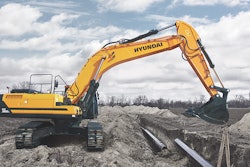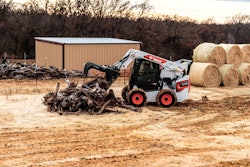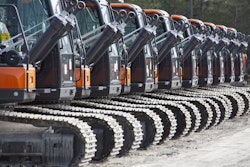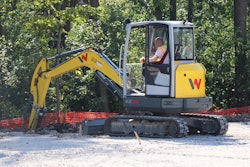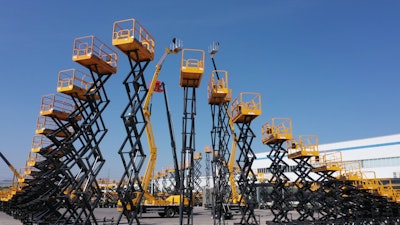 LiuGong’s recent introduction into the North American scissor lift market is part of its new rental thrust.
LiuGong’s recent introduction into the North American scissor lift market is part of its new rental thrust.Chinese manufacturer LiuGong is taking on some major initiatives in its quest for a deeper dive into the North American market.
Since the first of the year, it has announced a new global rental and used equipment initiative and said it would enter the rental-intensive North American scissor lift market. Another rental-focused product introduction: LiuGong’s F-Series compact excavators, which came out in September.
 Thieneman
Thieneman“Those products give us the right machines for rental companies and dealers,” says Kevin Thieneman, vice president, LiuGong Machinery, and chairman of LiuGong North America and LiuGong Latin America, speaking to Equipment World at the recent World of Concrete show. Thieneman came to LiuGong in 2017; his industry background includes 24 years at Caterpillar including a four-year stint as president of Caterpillar Forest Products.
Rental is a relatively new concept in China, says Thieneman. “We’re looking to stand rental up in China and then refine our approach for our dealers in North America and Europe,” he says. All rental channels – chains, independents and dealers – will be included in this rental thrust. And in a just-announced move, corporate parent Guangxi LiuGong Machinery bought Hertz China from Herc Holdings, which, with the move, divested all international holdings.
In addition to rental, LiuGong also announced in early February it was forming an international initiative into the aggregates market. The aggregates-focused team will work with dealers to address the needs of quarry and aggregate customers with its large wheel loaders, 50- to 90-ton excavators, ridged frame and wide-bodied trucks, and other products and services still in development.
“Our focus for the past year has been to fine tune the organization to think about customer segments,” Thieneman explains. “It’s an exciting time. We’re pushing the company hard to be more North American and European focused.”
LiuGong North America currently offers wheel loaders, excavators, compact excavators, skid steers, compact track loaders, Dressta dozers and forklifts. At the Bauma trade show last year LiuGong Group announced its vision to be a top 10 global construction equipment manufacturer by 2025.
Dealer development
North American dealer development is also being refined, Thieneman says. “We took a step back about two years ago and started looking for dealers with multiple locations within a territory and with the financial capacity to invest in a rental fleet.” LiuGong has also stepped up with subsidized wholesale plans, retail finance plans, rental consultation and product support, he says.
“We don’t want traders,” Thieneman say, “we want dealers who care about keeping machines running, so they they’ve got to love product support.”
Recruiting these dealers takes longer. “We’re not looking for quick, overnight solutions,” Thieneman says. While the company is seeking dealers in the top markets for equipment sales, “we’re casting a wide net. We’re talking to a lot of people, and we have a disciplined process,” he says.
“I see the dealer channel changing significantly,” Thieneman says. On one hand are the major OEM dealers, which is seeing consolidation. On the other side are the “more nimble dealers and it’s going to be interesting to watch,” he says. “I don’t think there’s one right answer, but it doesn’t make sense to have either 150 dealers or three dealers in North America.”
Integral to this change will be the generational change that’s happening among dealers, adds Thieneman. “Generally, there’s not a loss in the dealer relationship from generation one to generation two,” he says, but it becomes riskier in subsequent generations. “OEMs are having to spend more time on dealer transitions. Do you just put dealers together to solve your succession issue? It’s incumbent on the OEM to invest in dealer succession.”
As more private equity money makes its way into the industry, something may get lost if the focus shifts to short-term financial gain, Thieneman says. “What’s made our industry successful around the world is dealers who are in the community, and who’s reputation is on the line. They are personally invested in their customer’s success.”


